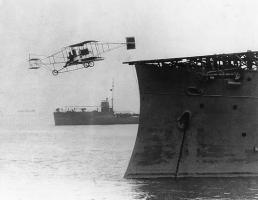 On November 14, 1910, one hundred and nine years ago today, pilot Eugene Burton Ely successfully took off in a biplane from the deck of the light cruiser USS Birmingham in the waters off Norfolk, Virginia, becoming the first pilot to fly a plane from the deck of a ship. He flew roughly three miles and landed onshore.
On November 14, 1910, one hundred and nine years ago today, pilot Eugene Burton Ely successfully took off in a biplane from the deck of the light cruiser USS Birmingham in the waters off Norfolk, Virginia, becoming the first pilot to fly a plane from the deck of a ship. He flew roughly three miles and landed onshore.
Two months later, on January 18, 1911, Ely landed his Curtiss Pusher biplane on a platform on the armored cruiser USS Pennsylvania anchored in San Francisco Bay, becoming the first pilot to land a plane on a ship. He stopped the plane using the first-ever tailhook arresting gear, designed and built by circus performer and aviator Hugh Robinson.
On October 19, 1911, Ely died in a crash at a flying exhibition in Macon, Georgia. He was only 24.
On February 16, 1933, Congress awarded the Distinguished Flying Cross posthumously to Ely, “for extraordinary achievement as a pioneer civilian aviator and for his significant contribution to the development of aviation in the United States Navy.”

The Curtis pusher is a very slow flying aircraft. It has so much lift that it is possible to spin the aircraft around in flight and be able to fly it backwards with out crashing.
A fact that is overlooked of early aviation. The Wright Brothers may have taken to the air with their Wright Flyer. They hoped to make money by holding a patent on wing warping as a means to control an airplane. This gave birth to the Curtis Flyer that used flaps to control airplanes. Thankfully he didnt demand everyone to pay him a fee for his design. Where as the Wrights expected anyone using wing warping were to get a royalty.
Fortunately for him the vessel was not underway!….that privilege belongs to Squadron Leader Dunning (RAF) in Scapa Floe, Orkney Scotland 1917, who was killed shortly after his flight durung the war in Europe. In fact America was way behind in the development of the flight decks.
I love the idea of being able to spin a plane and fly it backwards – how to confuse the enemy 🙂